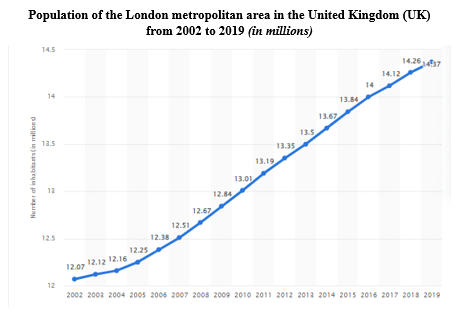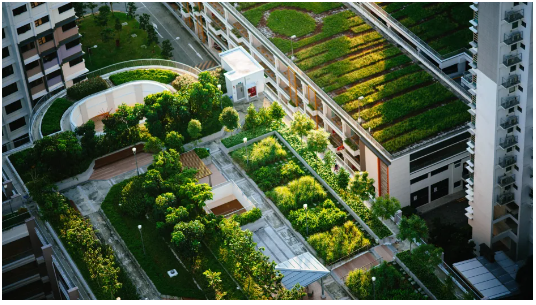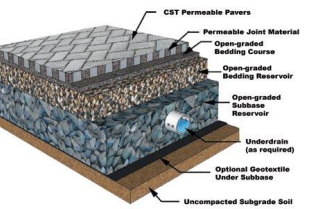Introduction
The system of parks, gardens, and green roofs that connect within a city is known as urban green infrastructure. Eco-friendly city planning is vital because it helps people and the environment in many ways. It will boost biodiversity, reduce urban heat islands, enhance air and water quality, and give people somewhere to play.
The City of London, as a central international financial hub, is an excellent location to consider when designing urban green infrastructure. Sustainable development is critical because the city’s economy and environment are inextricably linked. The city’s natural resources and biodiversity are threatened by climate change, urbanization, and population growth. Green infrastructure and nature-based solutions are integrated into urban planning and development to mitigate the effects of these challenges.
These issues are exacerbated by the city’s unchecked growth, increasing population, increased demand for housing, and increased need for infrastructure. Regional green infrastructure projects aid in the restoration of ecosystems as well as the mitigation of climate change (Vásquez et al., 2019). Municipal governments, community groups, and environmental organizations collaborate and involve stakeholders through qualitative and quantitative strategies to achieve these goals (Fernando, 2019).
According to Pauleit et al. (2019), the effects of climate change on biodiversity, ecosystems, pollution, and flooding threaten urban areas. The ability to track progress and make adjustments as needed is critical for the success of projects like these. The importance of urban green infrastructure for sustainable development, combined with the City of London’s status as a central international financial hub, necessitates a more comprehensive and coordinated approach to urban planning and construction.
Objective
The primary goal of this project is to provide a thorough understanding of urban green infrastructure and its significance for sustainable development in the City of London. This project looks into the concepts of green infrastructure and how it mitigates the effects of climate change in populated areas.
Understanding Urban Green Infrastructure
Green infrastructure (GI) is an essential concept in planning integrated landscape resources based on environmental management. Parks, green roofs, urban forests, and green walls are all examples of GI, as shown in Figure 1 below. According to Filazzola, Shrestha, and MacIvor (2019), GI provides a variety of ecosystem services to cities.
It is not a novel concept but rather a response to maintaining a balanced ecosystem in congested urban areas. GI has evolved over the last decade into a method for dealing with the dislocation caused by urbanization (Mell & Clement, 2019). Urban green infrastructure helps mitigate the effects of global warming, diminishing resources, and environmental degradation by improving people’s health and the environment.

Urban green infrastructure offers a variety of environmental, social, and economic advantages. To mitigate the severity of the effects of climate change, GI is used to improve air and water quality, increase biodiversity, and reduce the urban heat island effect (Vásquez et al., 2019). Kumar et al. (2019) discovered that GI increases time in nature, reduces pollution exposure, and promotes rest and physical activity.
For example, urban parks provide a tranquil setting to relax, de-stress, and connect with one’s community (Mohamed & Hussein, 2020). Green streets, which use plants, soil, and specialized equipment to delay, filter, and purify stormwater, help reduce flooding and water pollution (Hou et al., 2019). GI has the potential to boost the economy and create jobs, particularly in the tourism and green economy sectors.
Unfortunately, implementing urban green infrastructure in London faces several challenges, including a scarcity of affordable land in densely populated areas, which is a significant impediment to developing new green infrastructure projects. The implementation and maintenance costs may be high, necessitating long-term funding and financing strategies (Mell & Clement, 2019). Community engagement and participation, while critical to the success of GI projects, are challenging to achieve because not all communities are equally aware of or interested in environmental issues (Fernando, 2019). Policy and governance arrangements are critical to the success of GI projects, which differ between governmental levels and industries.
Despite these challenges, the City of London is committed to promoting urban green infrastructure as an essential component of its sustainability agenda. The mayor has proposed expanding the city’s green infrastructure to make London the world’s first National Park City (Green Infrastructure, 2023). To accomplish this objective, the government, businesses, and community will prioritize and plan green infrastructure, such as urban greening features like green roofs and street trees. Green infrastructure is becoming more critical as cities worldwide strive to improve their residents’ quality of life while combating climate change and the effects of rapid urbanization.
Methodology of the Project
The methodology for addressing the issue of urban green infrastructure in London involves several steps. The project will start with a literature review to determine the benefits and drawbacks of green infrastructure approaches. It will later assess the land to determine the best locations to implement green infrastructure measures. Consultations with community members, businesses, and government officials will occur to learn more about their priorities and expectations. Finally, the financial viability of the strategies will be evaluated using a cost-benefit analysis. The chosen green infrastructure strategies will then be implemented, and their progress will be tracked over time.
Project Development and Analysis
The importance of the suggested project for green infrastructure and landscape planning solutions in London has been recognized. Citizens’ quality of life will improve, biodiversity will flourish, and climate change will be mitigated due to this project. The proposed GI project includes more street tree planting and the creation of urban forests, parks, green roofs, green walls, and rain gardens. These components work together to improve air and water quality, reduce pollution, and increase biodiversity (Wang et al., 2019). The project aims to improve environmental quality and increase climate change resilience by creating a citywide network of green spaces and connections.
The project will be implemented in stages over the next five years. The first step in determining the best locations for green infrastructure components is to consult with stakeholders and the general public. It will create a budget during this stage and determine the best use of resources. Green roofs, Permeable Pavement, walls, and rain gardens will be installed in the second phase. The third stage will involve planting street trees and developing urban forests in various communities. The final step is to maintain and monitor the existing green infrastructure elements.
During the implementation phase, key stakeholders are involved in the project, bringing together various levels of government, non-profits, businesses, and individuals. It ensures people drive the project and address each area’s concerns. The Steinitz framework, an all-encompassing landscape analysis and planning method, will be used to evaluate the proposed solutions. This framework is divided into six stages: discovery, preparation, design, execution, management, and assessment (Hollstein, 2019).
The project’s success in producing the desired results will be measured by examining the environmental, social, and economic impacts it has had. Human health indicators such as activity levels, mental health, and air and water quality will be tracked as they change. The project’s long-term viability and cost-effectiveness will be considered during the review process.
The offered solutions for green infrastructure and landscape planning projects in London aim, among other things, to restore natural ecosystems, promote biodiversity, and reduce greenhouse gas emissions. The involvement of stakeholders, the allocation of resources, and regular maintenance and monitoring are all critical components of the implementation process (Liberalesso et al., 2020). The Steinitz model will be used to ensure that the project achieves its goals. If the recommended measures are implemented, the city will become a national model for sustainable urban development and green infrastructure.
Designing and Implementing Urban Green Infrastructure Projects in the City of London
Scope of Green Infrastructure
Industrialization and manufacturing activities have exacerbated the effects of climate change and pollution. There has been a mass exodus to London from previously habitable parts of the United Kingdom. It has increased the city’s population, as shown in Figure 2 by Clark (2022). Unfortunately, due to migration, urbanization has contributed to resource depletion and global warming. Climate change has been linked to migration, and this project aims to mitigate those effects. The goal of these proposals is to improve city life. Building drainage systems, water traps, and erosion gutters are all examples of solutions to the problem. These efforts have resulted in the city’s repopulation and decreased the harm urbanization has done to the environment.

Green Infrastructure Strategies
Green Roofs
Vegetation is grown on green roofs, a form of green infrastructure covering the tops of buildings. The rooftops are planted with low-maintenance plants and coated with lightweight dirt to reduce the energy needed to run the building, improve people’s health, and make the surrounding environment aesthetically pleasing (Hardman & Davies, 2019). They are helpful to humans in addition to being good for the environment, as Figure 3 shows.

Permeable Pavement
Permeable pavements are another type of green infrastructure since they reduce floods and air pollution while taking in environmental pollutants. Water passes through and is absorbed into the earth since the pavement is built of porous materials (Razzaghmanesh & Beecham, 2018). The pavement is used to avoid flooding by reducing runoff (Hall et al., 2019). Permeable pavements are a cost-effective solution to control stormwater and are illustrated in Figure 4.

Green Streets
Green street development has become a popular application of GI. Its purpose is to improve the environment and make cities and urban centers more livable. Stormwater management technologies, vegetation such as shrubs, trees, perennials, soil, and systems that slow, filter, and purify runoff are implemented (Zuniga-Teran et al., 2019). The initiative has been met with much success and is continuing to be used to create a better living space.
Rain gardens
Rain gardens are a type of green infrastructure that slows down the flow of rainwater because the soil and plants in the garden hold and filter the water, making it safely absorbed into the ground. Rain gardens have been shown to reduce the number of pollutants and sediment entering local rivers, streams, and other water sources, according to Bąk and Barjenbruch (2022). As a result, they improve the area’s overall water quality.
Urban Forestry
Urban forestry is a type of green infrastructure that entails planting trees, shrubs, and bushes in urban areas. Trees have numerous good benefits for their surroundings, such as cleansing the air, lowering the need for energy, and giving a home to wildlife. Muscarella et al. (2018) note that trees help reduce noise pollution and raise property values. Urban forestry is an effective method of environmental improvement and producing a healthy, sustainable environment.
The Implementation Process
London’s proposed green infrastructure and landscape planning solutions will necessitate a multi-stage implementation process. The project will create a comprehensive strategy and timeline to ensure timely and successful completion. Government grants, private sector investment, and charitable contributions will help fund the project. The participation of stakeholders is critical to a project’s success (Kumar et al., 2019).
As part of this process, consultation with neighborhood residents, business owners, and government officials will ensure all stakeholders appreciate the final product. Collaboration with local and environmental groups helps increase project support. Stakeholders will be informed and involved in the project’s development through regular communication and updates throughout the implementation process. By implementing a collaborative and inclusive strategy, the project will be successful and beneficial to all parties.
Evaluating the Impact of Urban Green Infrastructure in the City of London
For the proposed urban green infrastructure projects to reach their goals, their effects on the environment, society, and economy are examined. Green infrastructure offers a wide range of environmental benefits, including improved air quality, reduced pollution and runoff, and increased urban vegetation (Kumar et al., 2019). Installing green roofs, permeable pavements, green streets, rain gardens, and urban forestry helps reduce runoff and pollutants in surrounding ecosystems. Green infrastructure helps create habitats for various animals and provides natural cover that reduces air pollution and the effects of urban heat islands. It promotes good health by making people’s environments more stimulating.
Due to advancements in green infrastructure technologies, urban heat islands are reduced, air quality is improved, and new habitats for diverse species are made possible. Implementing green infrastructure plans boosts tourism and the economy. Long-term investments in environmentally friendly infrastructure pay off through lower operating costs, increased property values, and increased business activity (Kumar et al., 2019). Cities with well-developed green infrastructure generally have more prosperous economies.
The Steinitz framework is used to assess the potential benefits of green infrastructure projects in cities. This framework evaluates green infrastructure projects considering environmental, social, economic, and political factors (Hollstein, 2019). This framework will assess proposed solutions to ensure they are practical and beneficial to the community.
The success of London’s urban green infrastructure project relies heavily on ongoing monitoring and evaluation. The evaluation aims to determine whether or not the project met its objectives and what effect it had on the environment, society, and economy. At the gatherings, stakeholders assess the project’s progress, review what has been accomplished thus far, discuss any issues that have arisen, and make any necessary adjustments to keep the project on track.
Data is collected and analyzed regularly to assess the project’s effectiveness. Air and water quality indicators, community engagement and satisfaction, property values, and job creation are all examples of information collected. The project’s impact will be evaluated using the Steinitz Framework, a comprehensive tool for assessing the success of landscape designs. Surveys, focus groups, and town hall meetings are all effective methods for gathering feedback. The responses shed light on the project’s success and potential for expansion. Keeping the public updated on the project’s progress and results is critical. Reports, social media, and town hall meetings are just a few ways information is disseminated to the public. It is critical to keep the public informed about the project’s progress and outcomes so that they benefit and remain interested.
Conclusion
The presented urban green infrastructure project in the City of London is a significant step toward environmentally responsible growth. The project aims to boost economic growth, biodiversity, resilience to climate change, and people’s quality of life. Green roofs, urban forests, parks, green streets, and rain gardens are just a few of the project’s many features that provide environmental, social, and economic benefits.
The Steinitz framework evaluated the proposed solutions, revealing the project’s strengths and weaknesses. Stakeholder participation, financial resources, and assessment are just a few of the areas that need additional attention. Future research focuses on improving these aspects of the project and discovering new ways to plan and develop urban green infrastructure.
The City of London’s urban development agenda prioritizes urban green infrastructure to achieve sustainable development. If this project succeeds, it could serve as a model for other cities dealing with the effects of urbanization and climate change. The success of urban green infrastructure projects depends on the continued investment of the City of London and the active participation of stakeholders, businesses, and the community.
Reference List
Bąk, J. and Barjenbruch, M. (2022) ‘Benefits, inconveniences, and facilities of the application of rain gardens in urban spaces from the perspective of climate change—a review,’ Water, 14(7), p. 1153. Web.
Clark, D. (2022) London metropolitan area population 2019, statista. Web.
Fernando, L.R. (2019) ‘Solid waste management of local governments in the western province of sri lanka: an implementation analysis,’ waste management, 84, pp. 194–203. Web.
Filazzola, A., Shrestha, N. and MacIvor, J.S. (2019) ‘The contribution of constructed green infrastructure to urban biodiversity: a synthesis and meta‐analysis,’ journal of applied ecology, 56(9), pp. 2131–2143. Web.
Green Infrastructure (2023) London city hall. Web.
Hall, J.W., Harvey, H. and Manning, L.J. (2019) ‘Adaptation thresholds and pathways for tidal flood risk management in london,’ climate risk management, 24, pp. 42–58. Web.
Hardman, M. and Davies, N. (2019) Green roofs can make cities healthier and happier. why aren’t they everywhere? Fast Company. Web.
Hollstein, L.M. (2019) ‘Retrospective and reconsideration: the first 25 years of the steinitz framework for landscape architecture education and environmental design,’ landscape and urban planning, 186, pp. 56–66. Web.
Hou, J. et al. (2019) ‘Spatial simulation of the ecological processes of stormwater for sponge cities,’ journal of environmental management, 232, pp. 574–583. Web.
Kumar, P. et al. (2019) ‘The nexus between air pollution, green infrastructure and human health,’ environment international, 133, p. 105181. Web.
Liberalesso, T. et al. (2020) ‘Green infrastructure and public policies: an international review of green roofs and green walls incentives,’ land use policy, 96, p. 104693. Web.
Mell, I. and Clement, S. (2019) ‘Progressing green infrastructure planning: understanding its scalar, temporal, geo-spatial and disciplinary evolution,’ impact assessment and project appraisal, 38(6), pp. 449–463. Web.
Mohamed, N.A. and Hussein, H. (2020) ‘Perceived effect of urban park as a restorative environment for well-being in kuala lumpur,’ international journal of built environment and sustainability, 8(1), pp. 69–79. Web.
Muscarella, R. et al. (2018) ‘Effects of biotic interactions on tropical tree performance depend on abiotic conditions,’ ecology, 99(12), pp. 2740–2750. Web.
Nigam, V. (2019) Presentation on green infrastructure for urban areas, share and discover knowledge on slideshare. Web.
Pauleit, S. et al. (2019) ‘Advancing urban green infrastructure in europe: outcomes and reflections from the green surge project,’ urban forestry & urban greening, 40, pp. 4–16. Web.
Razzaghmanesh, M. and Beecham, S. (2018) ‘A review of permeable pavement clogging investigations and recommended maintenance regimes,’ water, 10(3), p. 337. Web.
Vásquez, A. et al. (2019) ‘Green infrastructure planning to tackle climate change in latin american cities,’ urban climates in latin america, pp. 329–354. Web.
Wang, J. et al. (2019) ‘Spatial patterns of urban green infrastructure for equity: a novel exploration,’ journal of cleaner production, 238, p. 117858. Web.
Zuniga-Teran, A.A. et al. (2019) ‘Challenges of mainstreaming green infrastructure in built environment professions,’ journal of environmental planning and management, 63(4), pp. 710–732. Web.
Appendix
